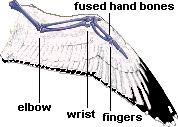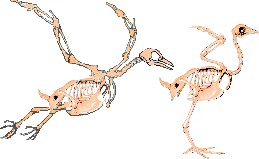 Bird Anatomy & Bird Parts Bird Anatomy & Bird Parts
Learning the anatomy of birds gives clues to
where they live and what they eat. Learning the shapes
and silhouettes of birds is helpful in identifying them at a
distance.
Designed for flight
Birds are one of the few animals that have developed the
ability to fly. Every part from the skeleton to the feathers
has evolved to aid in flight. The skeleton, while using the
same general design of other vertebrates has some distinct
differences. The skull is very light in proportion to
the rest of the body because there are no teeth for chewing,
or any heavy jaw or jaw muscles. The job of grinding up
food is performed by the gizzard. This means the skull
is usually around 1 percent of the body weight. The bones are hollow with strut like structures
inside. This makes them light while still making them strong
enough for flight. The forelimbs have developed into wings.
 The wings are composed of the
humerus or upper arm, and the radius or ulna, which makes up
the forearm with wrist, and hand bones. The forearm supports
the secondary feathers, and the fused wrist, and hand bones
support the primary feathers. The joints have added strength
because they have limited movement. The wings are composed of the
humerus or upper arm, and the radius or ulna, which makes up
the forearm with wrist, and hand bones. The forearm supports
the secondary feathers, and the fused wrist, and hand bones
support the primary feathers. The joints have added strength
because they have limited movement.

The skeleton has many modifications to allow
birds to walk on their hind legs.
The muscles have also evolved for flight. The important
muscles for flight run between the upper arm, and the breast.
There are two pairs of flight muscles. The larger pair called
the pectoralis major contracts for the down stroke. The
pectoralis minor handles the upstroke, which needs far less
power.
The body is the third part of this design for flight. It is
very streamlined to reduce friction. The smooth surface of
the feathers reduces the friction even more.
The tail consisting entirely of feathers aids in maneuvering.
The legs will usually be tucked under the body when flying so
they don't affect the flight.
Beaks Legs and Feet
Beaks of birds are varied depending on the species, and are specialized
for their particular diet. In most birds they are light to save weight for flight.
Bird beaks are bony structures covered with keratin, much like
our fingernails.
Just like bird beaks, the feet and legs of birds are
specialized depending on each bird's habits, and life style.
Here are examples of a few of the specialized beaks and feet.
| Drilling Holes The hard
beak of a woodpecker is good for drilling holes. |
 |
| Birds with short thin beaks usually
eat insects. |
 |
Cracking seeds A thick
short, or conical beak is good for cracking seeds.
Buntings, Cardinals, Grosbeaks, Towhees, Finches
... |
 |
| The bills of crossbills have lower
and upper mandibles crossed, making it easier for
them to eat pine cone seeds. They
start at the bottom of a cone and spiral upward,
opening each scale, and removing the seeds with
their tongues. |
 |
| Parrots have a different kind of
conical bill good for Cracking seeds. |
 |
| Scooping A
pelican's
pouch is used to scoop fish. When the fish
is caught the pouch contracts to squeeze out
water. |
 |
Birds such as thrashers and wrens,
with slender curved bills can probe for
insects.
|
 |
Straight slender bills are very versatile.
Large birds like crows are often omnivorous.
Small birds will feed largely on insects.
Blackbirds, Bluebirds, Chickadees, Crows,
Grackles, Jays, Magpies, Mockingbirds,
Meadowlarks, Orioles, Robins, Thrushes, |
 |
| Humming birds have long thin
beaks for getting nectar from flowers. |
 |
Bird Brain
The brains of birds have also developed for flight. The cerebellum is
the part that is responsible for co-ordination of movement.
Because birds make extremely fast moves at very high speeds
this part of the brain is large. The cerebral hemispheres,
which let the bird perform complex behavior patterns is also
very large. It turns out that many birds are quite intelligent even using tools and having
social communication.
Digestive system
Birds are very active animals. They use a lot of energy, and
consume food at a very rapid rate. Small birds may eat a third
of their body weight in a day. They have specially evolved
digestive systems with organs like the gizzard, not found in
other animals.
Birds can be herbivores, carnivores, or omnivores. The
herbivores feed on seeds, fruit, and other plants, and have a
more complex digestive system then carnivores, which feed on
meat.
Lungs
Another thing that is different in birds are the lungs. In
other vertebrates the lungs consist of sacs. Birds have
extensions to the lungs called air sacs. Inhaled air passes
through the air sacs and back thought the lungs. With
this system, oxygen is transferred to the blood during both
inhalation, and exhalation. This gives bird's better use
of oxygen for flying, and it allows them to get by with
smaller lungs than other vertebrates. This also aids birds that dive, and need to hold their
breath for long periods.
Sight
Birds eyes are much larger in relation to their heads than
ours, giving them the ability to see fine detail. They
process what they see faster than we do, and they are better
at detecting movement. Birds canít roll their eyes
like humans so they must turn their heads. When a robin
cocks its head to one side it is looking in that direction.
Having both monocular and binocular vision, birdís eyes work
together to see straight ahead as well as working
independently. This gives some birds an extremely wide
field of vision, even allowing some birds to see both in
front, and in back of themselves. Birds such as
waterfowl, or pigeons have very little binocular vision, and
wide monocular vision. Some birds such as the kingfisher
have droplets of color oil in the retinas that diminish the
glare of water when they are fishing. Others such as
raptors have eyes more towards the front of their heads giving them
better binocular vision, letting them judge distance better.
Plumage and Colors
While their colors are a thing of beauty to us, these
distinctive colors are important to the survival of birds.
Their colors help them attract mates, and protect them from
predators.
Females of most species choose their mates, and are attracted
to the male with the most colorful plumage. The color of
the male will become muted when breeding season ends.
The female will usually be duller than the male, and this
helps protect her from predators while she is nesting.
The markings of many birds give them camouflage allowing them
to blend in with their surroundings. A ruffed grouse
matches his surroundings so well it becomes almost invisible.
Many birds have counter shading to help protect them.
The back, which is exposed to light, is darker than the
breast, which is in shadow. The shade of sides will fade
gradually from light below to dark above. Many birds
have lighter under parts, and darker upper parts. This
gradual change in color makes them less conspicuous.
All adult birds molt at least once a year. Molting is
a process where old feathers are replace by new feathers.
As much as a third of the birdís body weight is replaced
during molting so they need a lot of protein. Many song
birds molt near the end of the summer, and they can look a bit
ragged at this time.
Learning common bird shapes
and silhouettes is helpful in identifying birds at a
distance. Learning the anatomy of birds provides clues to where birds
live and what they eat.
 bird charts and posters
bird charts and posters

|
